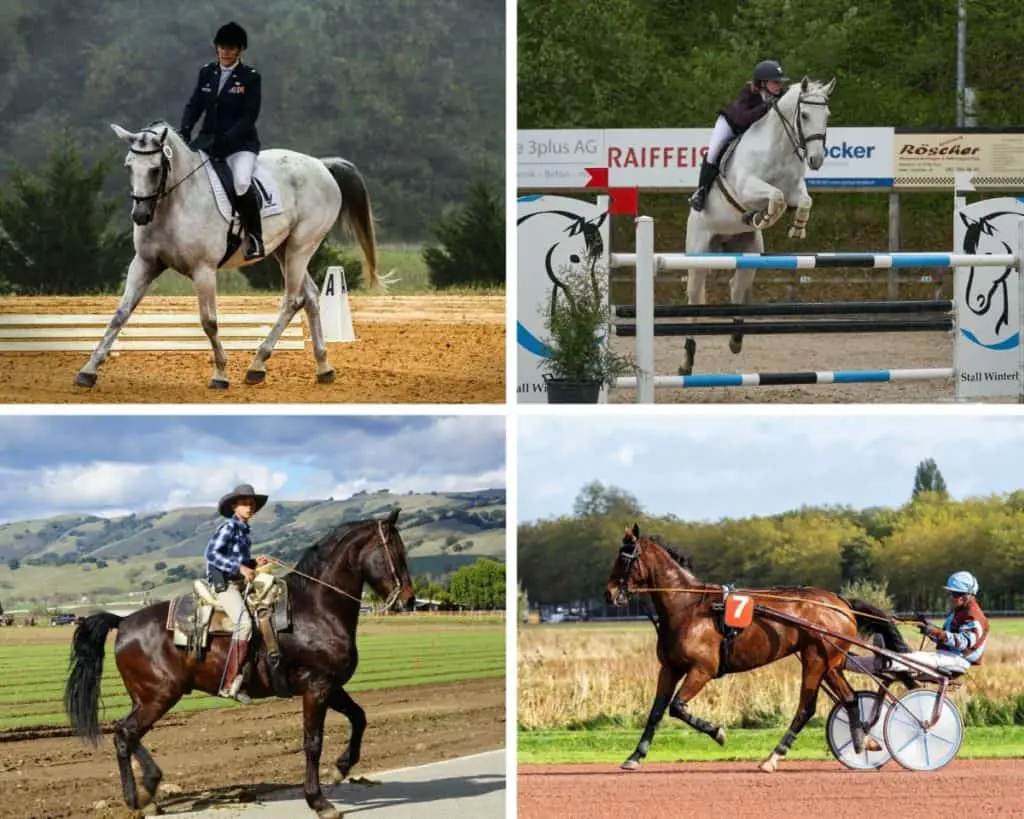Hey there! In this article, we’re going to talk about different types of horseback riding competitions. You’ll learn about the various disciplines and events that take place in the equestrian world. We’ll explore everything from dressage and show jumping to barrel racing and endurance riding. By the end, you’ll have a better understanding of the exciting and diverse world of horseback riding competitions. So, let’s saddle up and dive into the world of equestrian sports!
Exploring Different Types of Horseback Riding Competitions
Horseback riding is not only a recreational activity but also a competitive sport that offers various types of competitions. Whether you are a seasoned rider or a novice equestrian enthusiast, there is a competition for every level and interest. In this article, we will delve into the different types of horseback riding competitions, including dressage, show jumping, eventing, endurance riding, barrel racing, western pleasure, reining, vaulting, polo, rodeo, cross country, mounted games, pony club, and trail riding. So, saddle up and let’s explore the exciting world of horseback riding competitions!
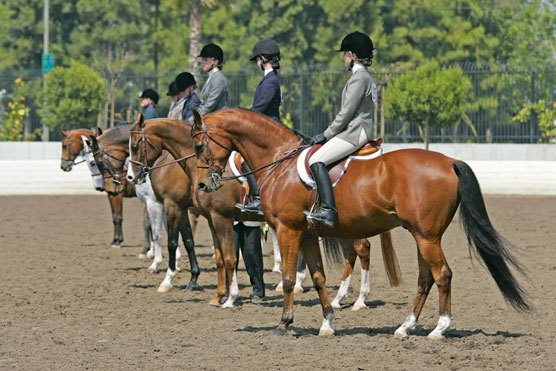
Dressage
Overview
Dressage is often referred to as ‘horse ballet.’ It is an equestrian sport that showcases the horse’s elegance, precision, and obedience to its rider’s subtle commands. During a dressage competition, horse and rider perform a series of predetermined movements in an arena, focusing on the horse’s suppleness, impulsion, and submission to the rider’s aids.
Scoring and Judging
Dressage is judged subjectively, with a panel of judges awarding scores based on the horse’s performance and the rider’s ability to communicate with the horse effectively. The scoring is based on the correctness, quality, and harmony of the movements executed.
Dressage Movements
The movements in dressage include precise turns, circles, transitions between gaits, and various lateral movements such as shoulder-in, haunches-in, and leg-yield. Advanced dressage movements can include piaffe, passage, and pirouettes. The goal is to achieve perfect harmony and fluidity between horse and rider.
Levels of Competitions
Dressage competitions are divided into levels, ranging from introductory or training level to the grand prix level. Each level has its own set of movements and difficulty, designed to progressively challenge the horse and rider’s partnership.
Famous Dressage Horses
Famous dressage horses like Valegro, Totilas, and Isabell Werth’s Bella Rose have dazzled the dressage world with their impressive performances. These horses have showcased the epitome of elegance, precision, and partnership between horse and rider in the dressage arena.
Training for Dressage
Training for dressage requires a strong foundation in basic horsemanship, including proper balance, position, and communication with the horse. It also involves consistent practice and refinement of the horse’s movements and the rider’s aids.
Show Jumping
Overview
Show jumping is an exhilarating equestrian sport that tests the horse and rider’s ability to navigate a course of obstacles, including jumps, combinations, and related distances. The objective is to clear the obstacles cleanly and within the allotted time.
Course Design
Show jumping courses are designed with a variety of obstacles, including verticals, oxers, combinations, and technical questions such as tight turns and rollbacks. The course can be set indoors or outdoors, depending on the competition venue.
Scoring and Judging
Show jumping is scored based on faults incurred during the round. Faults can be penalties for knocking down jumps, refusing a jump, or exceeding the time allowed. The horse and rider with the fewest faults and fastest time, if there is a jump-off, are declared the winners.
Types of Jumps
Show jumping jumps come in various types, sizes, and styles. Verticals are single fences with poles set on upright standards. Oxers consist of two verticals placed side by side to create a spread. Triple bars and liverpools are other types of jumps that add complexity and challenge to the course.
Famous Show Jumping Horses
Horses like Hickstead, Big Ben, and Gem Twist have left an indelible mark in the show jumping world. These exceptional athletes have displayed tremendous athleticism, courage, and scope, making them legendary figures in the sport.
Training for Show Jumping
Training for show jumping involves developing the horse’s jumping technique, adjustability, and agility, as well as the rider’s ability to accurately assess distances and maintain a balanced position. It also includes conditioning both the horse and rider for the physical demands of the sport.
Eventing
Overview
Eventing, also known as the three-day event, tests the versatility and stamina of both horse and rider in three distinct phases: dressage, cross country, and show jumping. It is often considered the ultimate test of horsemanship, combining precision, endurance, and skill.
Three Phases
The dressage phase evaluates the horse’s obedience, suppleness, and athleticism through a series of predetermined movements. The cross country phase challenges the horse and rider’s bravery and fitness as they navigate a course of natural obstacles within a set time. The show jumping phase assesses their precision and agility in clearing a course of fences.
Scoring and Judging
Eventing is scored based on penalties incurred in each phase. Penalties can be for disobedience, knocked down fences, or exceeding the time allowed. The horse and rider with the fewest penalties are declared the winners.
Dressage Test
The dressage test in eventing differs from pure dressage competitions, focusing more on obedience and relaxation rather than intricate movements. The goal is to demonstrate the horse’s ability to perform under pressure.
Cross Country Course
The cross country course in eventing features natural obstacles such as logs, water jumps, ditches, and banks. The course is designed to mimic the challenges encountered when riding in the open countryside.
Show Jumping Phase
The show jumping phase in eventing is similar to pure show jumping competitions, with a course of fences to be cleared without penalties. It tests the horse and rider’s precision and ability to adjust to different types of jumps.
Famous Eventing Horses
Horses like Michael Jung’s Sam, William Fox-Pitt’s Tamarillo, and Mark Todd’s Charisma have achieved remarkable success in the eventing world. Their exceptional athleticism, bravery, and partnership with their riders have made them true legends in the sport.
Training for Eventing
Training for eventing requires a well-rounded approach, focusing on developing the horse’s skills in all three phases and the rider’s ability to communicate effectively in different disciplines. It also involves conditioning both horse and rider for the physical demands of endurance and agility.
Endurance
Overview
Endurance riding tests the horse and rider’s ability to cover long distances within a set time, often spanning 50 to 100 miles or more in a single day. The objective is to complete the course in the fastest time while ensuring the horse’s welfare and soundness.
Long Distance Riding
Endurance riding takes place across varying terrains, including desert, mountains, and forests. The riders must navigate challenging trail conditions, weather, and elevation changes, showcasing the horse’s endurance, stamina, and adaptability.
Scoring and Judging
Endurance riding is scored based on a combination of factors, including completion time, the horse’s heart rate and soundness, and veterinary checks throughout the ride. Horses must pass regular vet checks to ensure their well-being during the competition.
Equipment for Endurance Riding
Endurance riders use specialized equipment, such as lightweight saddles and bridles designed to maximize comfort and minimize weight. Riders also carry essential supplies, including water, food, and first aid kits, to ensure the welfare of horse and rider throughout the ride.
Training for Endurance Riding
Training for endurance riding involves gradually building the horse’s fitness and conditioning through long-distance rides and regular exercise. It also includes monitoring the horse’s heart rate, hydration, and nutrition to ensure optimal performance and well-being.
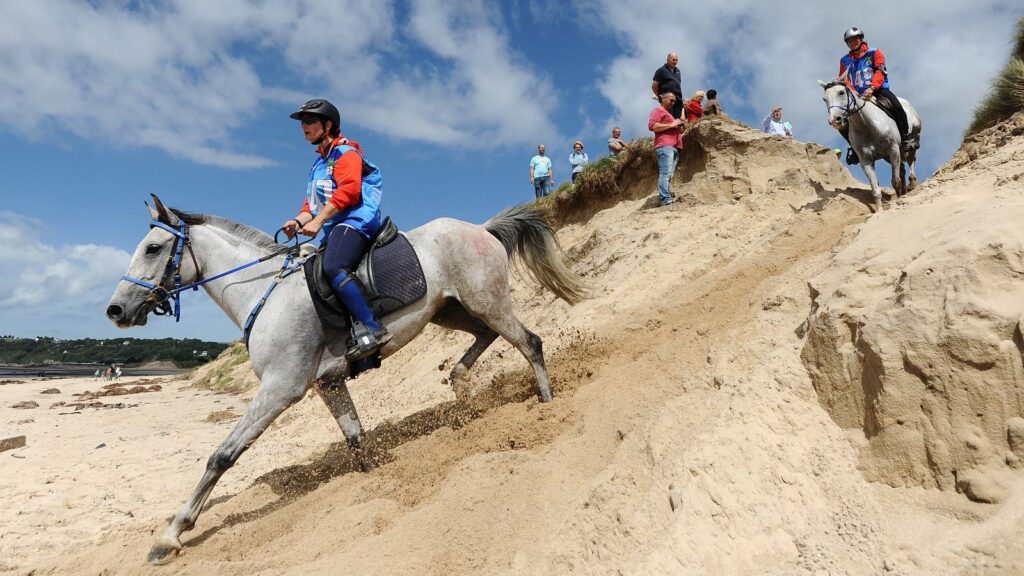
Barrel Racing
Overview
Barrel racing is a fast-paced, thrilling rodeo event that showcases the horse and rider’s speed, agility, and precision. The objective is to complete a cloverleaf pattern around three barrels in the shortest time possible.
Course Design
Barrel racing courses consist of three barrels arranged in a cloverleaf pattern, with a designated starting and finishing point. The rider must navigate the course without knocking over any barrels and complete it in the fastest time possible.
Scoring and Timing
Barrel racing is timed using electronic timers that measure the horse and rider’s speed from start to finish. Knocking over a barrel results in a time penalty. The fastest time without penalties is declared the winner.
Types of Barrels
Barrels used in barrel racing are lightweight and designed to easily fall if touched. The standard size for barrels is 55 gallons, although smaller barrels are sometimes used for younger or smaller horses.
Training for Barrel Racing
Training for barrel racing involves developing the horse’s speed, agility, and ability to efficiently navigate tight turns. Riders must also have excellent horsemanship skills, including balance, timing, and clear communication with the horse.
Western Pleasure
Overview
Western pleasure is a competition that showcases the smooth and relaxed gaits of the horse, emphasizing its temperament and suitability for riding in a western-style saddle. The objective is to demonstrate the horse’s willingness, responsiveness, and smooth gaits.
Ideal Gaits and Movements
In western pleasure, the ideal gaits are a relaxed and slow walk, jog, and lope. The horse should demonstrate a smooth, flowing movement with a relaxed head carriage and no resistance or excessive speed.
Attire and Tack
Western pleasure competitors wear traditional western attire, including cowboy hats, long-sleeved shirts, jeans, and western-style boots. The horse’s tack includes a western saddle, bridle, and potentially additional equipment like martingales or tie-downs.
Scoring and Judging
Western pleasure is judged subjectively, with judges awarding scores based on the horse’s overall performance, including gaits, behavior, and responsiveness to the rider’s cues. The judging criteria include the horse’s smoothness, balance, attitude, and overall suitability for western riding.
Training for Western Pleasure
Training for western pleasure involves teaching the horse to relax and perform the desired gaits smoothly. This includes developing a consistent rhythm, correct head carriage, and responsiveness to the rider’s cues. The horse must also demonstrate good manners and a calm temperament in the show ring.
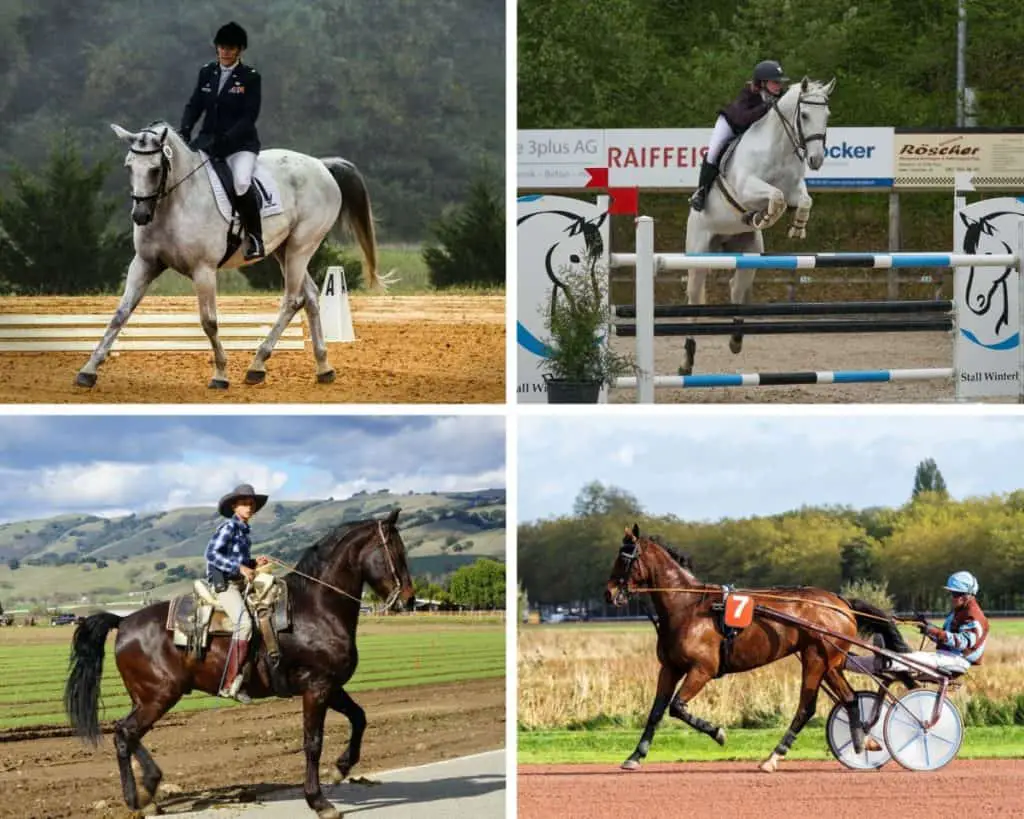
Reining
Overview
Reining is a western riding competition that highlights the horse’s skill and precision in executing a series of movements, including spins, sliding stops, and flying lead changes. It emphasizes the horse’s athleticism, responsiveness, and training in the western riding style.
Patterns and Movements
Reining patterns consist of a series of movements performed at different gaits. These movements include circles, spins, sliding stops, rollbacks, and flying lead changes. The horse and rider must execute the movements with finesse and accuracy.
Scoring and Judging
Reining is scored based on the horse and rider’s execution and precision in performing the required movements. Judges evaluate the horse’s speed, smoothness, control, and overall correctness. The highest-scoring horse and rider combination is declared the winner.
Attire and Tack
Participants in reining competitions wear traditional western attire, including western hats, long-sleeved shirts, jeans, and western boots. The horse is outfitted with a western saddle, bridle, and potentially additional equipment like spurs or tie-downs.
Training for Reining
Training for reining involves teaching the horse the specific movements required in the competition and refining their execution. It requires a high level of obedience, responsiveness, and athleticism. Riders must develop excellent horsemanship skills, including balance, timing, and clear communication with the horse.
Vaulting
Overview
Vaulting combines gymnastic exercises with horseback riding, showcasing the horse and vaulter’s coordination, balance, and precise movements. It is often performed in teams or individually and requires the horse to move in a consistent, rhythmic circle while the vaulter performs various maneuvers.
Team or Individual
Vaulting competitions can be performed as a team or individual, with each vaulter showcasing their gymnastic skills on the moving horse. Teams usually consist of multiple vaulters performing synchronized movements, adding an element of teamwork to the competition.
Movements and Maneuvers
Vaulting movements and maneuvers range from basic poses and balances to more complex acrobatic exercises, including handstands, splits, and jumps. Vaulters must maintain balance and coordination while performing these movements on the horse’s back.
Scoring and Judging
Vaulting is judged based on the vaulter’s control, form, difficulty of movements performed, and their harmony with the horse. Judges evaluate the vaulters’ execution, technique, and overall presentation. The highest-scoring vaulter or team is declared the winner.
Training for Vaulting
Training for vaulting involves developing the vaulter’s strength, flexibility, and coordination, as well as the horse’s ability to maintain a steady, rhythmic pace. The vaulter must learn to trust and communicate with the horse, as well as execute the gymnastic movements with precision.
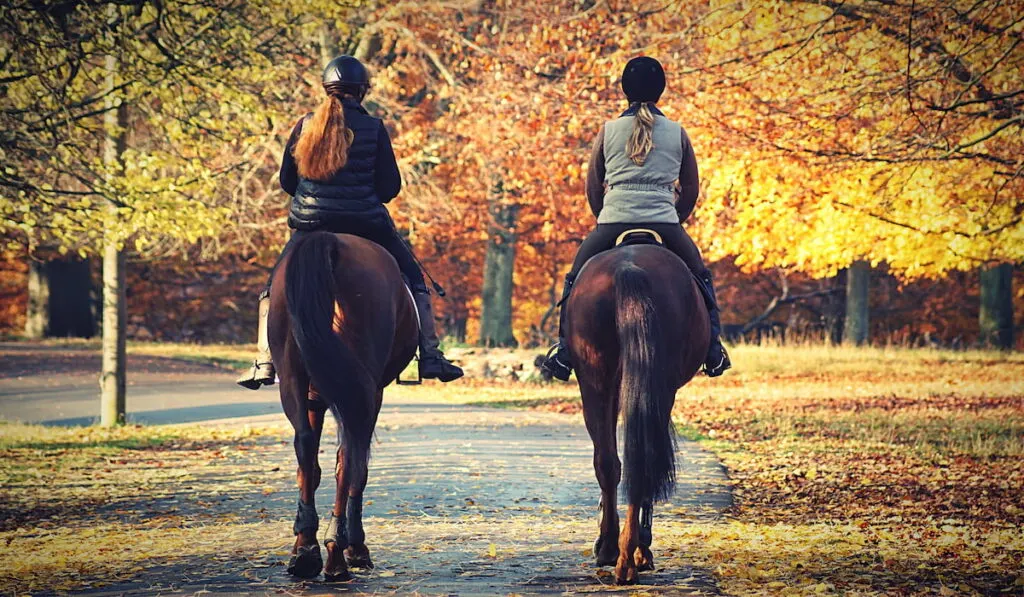
Polo
Overview
Polo is a dynamic and fast-paced equestrian sport that combines horsemanship, teamwork, and strategic thinking. It is played on horseback with teams of four riders, each aiming to score goals by hitting a small ball into the opposing team’s goal using a long-handled mallet.
Rules of the Game
Polo is played on a large field, and each team tries to outscore the other by hitting the ball with their mallets and maneuvering it towards the goal. The game is divided into periods called chukkers, and the team with the highest score at the end of the match is declared the winner.
Skills and Positions
Polo requires riders to have excellent horsemanship skills, balance, and agility. Each team member has a specific position and role, including the offensive players, defensive players, and the team captain, known as the “number one” position.
Horses in Polo
Polo horses, also known as polo ponies, are highly trained and agile. They must possess speed, endurance, and the ability to quickly and responsively change direction. Multiple horses are used per game, allowing players to switch to a fresh horse when needed.
Training for Polo
Training for polo involves developing the horse’s fitness, agility, and responsiveness to the rider’s cues. It also includes honing the rider’s skills in hitting the ball accurately and effectively, as well as understanding the nuances of positioning and strategy in the game.
Rodeo
Overview
Rodeo is a popular and action-filled sport that showcases the skills of both cowboys and cowgirls in various events related to working with livestock. It combines traditional ranching tasks with competitive sportsmanship and entertainment.
Rodeo Events
Rodeo events can include bull riding, saddle bronc riding, bareback bronc riding, steer wrestling, tie-down roping, team roping, barrel racing, and bull roping. Each event tests different skills, such as balance, strength, and agility.
Rodeo Animals
Rodeo events often involve livestock, primarily bucking bulls, broncos, and calves. These animals are bred and trained specifically for rodeo competitions, ensuring their safety and well-being throughout the events.
Rodeo Attire
In rodeo competitions, cowboys and cowgirls wear traditional western attire, including cowboy hats, long-sleeved shirts, jeans, chaps, and western boots. The attire is both functional for riding and a nod to the history and culture of the sport.
Rodeo Safety
Safety is a top priority in rodeo competitions. Extensive measures are taken to ensure the safety of both the contestants and the animals involved. Rodeo officials and veterinarians closely monitor the events to address any potential risks or injuries.
Training for Rodeo Events
Training for rodeo events requires specialized skills and techniques for each event. Participants must develop excellent horsemanship skills, strength, and agility, as well as understand the specific strategies and maneuvers needed to succeed in their chosen events.
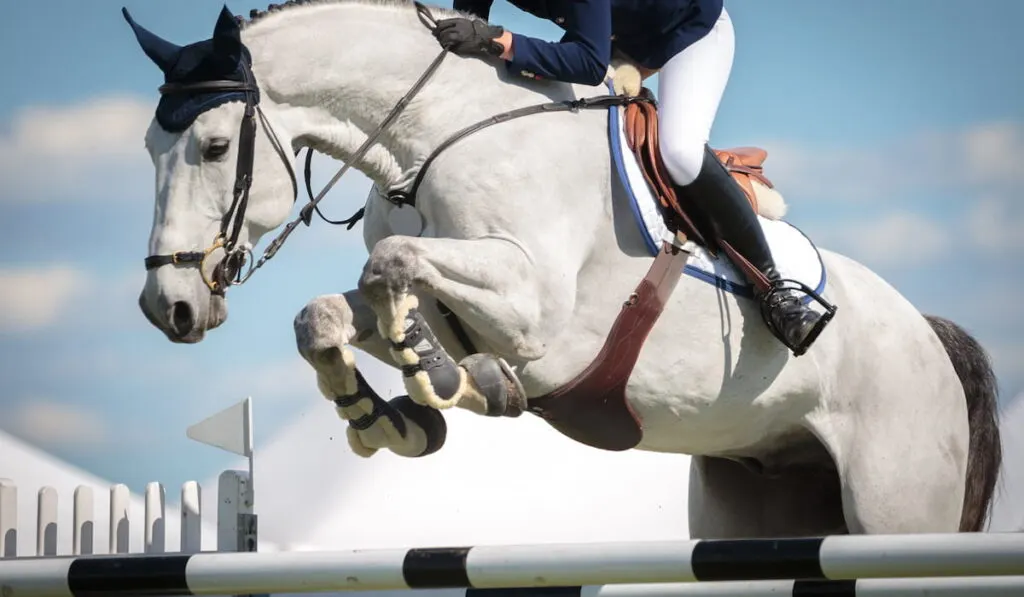
Cross Country
Overview
Cross country riding combines elements of dressage, endurance, and jumping, testing the horse and rider’s athletic ability, courage, and partnership as they navigate a challenging course of natural obstacles, wide-open spaces, and varied terrain.
Course Design
Cross country courses are designed to simulate riding in the open countryside, incorporating natural obstacles such as logs, ditches, water jumps, and banks. The course can be set on varied terrain, including fields, forests, and hills, to add complexity and challenge.
Scoring and Timing
Cross country riding is scored based on the completion time and penalties incurred. Penalties can be for knocked down jumps, refusals, or exceeding the optimum time. The aim is to complete the course with the fastest time and the fewest penalties.
Types of Obstacles
Cross country obstacles come in various types, sizes, and difficulties. These can include solid fences, water obstacles, banks, ditches, and combinations of jumps. The rider must assess each obstacle’s line, speed, and approach to successfully clear them.
Training for Cross Country Riding
Training for cross country riding requires a strong foundation in basic horsemanship, as well as specific skills such as jumping technique, balance, and fitness. Riders must practice riding over varied terrain and familiarize themselves with the different types of obstacles encountered in cross country courses.
Mounted Games
Overview
Mounted games is a fast-paced and exciting equestrian sport that involves a team of riders competing against each other in various relay races and skill-based games. It tests the riders’ speed, agility, control, and coordination with their horses.
Popular Games
Mounted games include a variety of relay races and games, such as pole bending, flag race, mug shuffle, sack race, and bending race. These games require the rider and horse to complete specific tasks quickly and accurately.
Skills and Techniques
Mounted games demand riders to have excellent horsemanship skills, including balance, control, and effective communication with their horses. They must adapt quickly to different games and perform tasks with precision while on horseback.
Scoring and Timing
Mounted games are scored based on the completion time of the relay race or game and penalties incurred, such as dropping objects or going off-course. The team with the fastest time and fewest penalties is declared the winner.
Training for Mounted Games
Training for mounted games involves developing the rider’s speed, agility, and coordination, as well as the horse’s responsiveness and adaptability to quick movements. Riders must practice the specific skills required for each game and refine their horsemanship abilities.
Pony Club
Overview
Pony Club is an international organization that provides equestrian education and opportunities for young riders. It offers a range of activities, including riding instruction, horse care education, and competitive events, to foster horsemanship skills and sportsmanship.
Benefits of Pony Club
Joining a Pony Club offers numerous benefits, including access to qualified riding instructors, educational materials, and a supportive community of fellow young equestrians. It provides a safe and structured environment for young riders to learn and grow in their equestrian journey.
Pony Club Activities
Pony Club activities can include mounted lessons, horse management workshops, rallies, competitions, and social events. Members get the chance to improve their riding skills, learn proper horse care, and interact with other young horse enthusiasts.
Levels and Progression
Pony Club offers a progression through various levels, allowing riders to advance their skills and knowledge. Members earn certificates and awards as they meet specific criteria, encouraging continuous learning and development.
Training for Pony Club
Training for Pony Club involves attending mounted and unmounted lessons, as well as participating in workshops and clinics. Members learn about horse care, riding techniques, stable management, and sportsmanship. They also have the opportunity to represent their Pony Club in various competitions and events.
Trail Riding
Overview
Trail riding is a recreational activity that involves riding horses on designated trails and exploring natural landscapes. It offers riders the opportunity to unwind, connect with nature, and enjoy the serenity of horseback riding in scenic environments.
Benefits of Trail Riding
Trail riding provides numerous benefits, including physical exercise, mental relaxation, and the opportunity to bond with horses and fellow riders. It allows riders to explore new areas, appreciate nature, and escape the hustle and bustle of everyday life.
Choosing Trails
When trail riding, riders should choose trails suitable for their skill level and the horse’s fitness and experience. They should consider factors such as trail length, terrain difficulty, and any potential hazards or obstacles along the route.
Safety on the Trails
Safety is paramount when trail riding. Riders should wear appropriate safety gear, including helmets, and carry essential supplies such as first aid kits and cell phones. They should also be aware of trail etiquette and be respectful of other trail users.
Training for Trail Riding
Training for trail riding involves ensuring the horse is comfortable and familiar with riding on varied terrain and encountering potential obstacles. Riders must develop their horsemanship skills, focusing on balance, relaxation, and clear communication with the horse.
Conclusion
Participating in horseback riding competitions offers a thrilling and rewarding experience for riders of all ages and skill levels. Whether you choose to compete in dressage, show jumping, eventing, endurance riding, or any other type of competition, the world of equestrian sports has something to offer. By exploring the different types of horseback riding competitions, you can discover your passion and embark on a journey of growth, learning, and unforgettable experiences with your equine partner. So, saddle up, dive into the competition of your choice, and enjoy the incredible world of horseback riding!
